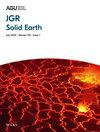On the Choice of Basis Functions for Modeling Earth's Elastic Deformation Due To Surface Loading
IF 4.1
2区 地球科学
Q1 GEOCHEMISTRY & GEOPHYSICS
引用次数: 0
Abstract
Accurately modeling Earth's elastic deformation due to surface loads is essential for geodetic and geophysical studies, including investigations of climate change, hydrology, and tectonics. Various basis functions, such as spherical harmonics, Green's functions, disk functions, and Slepian functions, are commonly used to describe the relationship between surface loads and deformation. However, the strengths and limitations of these basis functions have not been systematically compared, leading to potential uncertainties in the modeling results. This study evaluates six basis functions, including the above four and two newly developed approaches of infinite Green's functions and clustered disk-load Green's functions. We analyze their performance in forward modeling of Earth's vertical displacement and assess two primary sources of uncertainty: (a) native errors inherent to each basis function and (b) artificial errors introduced by improper configuration, for example, over-smoothing and aliasing. Our results demonstrate that these errors can be as significant as the uncertainties associated with Earth structure assumptions. Furthermore, we emphasize the importance of how surface load data is treated, whether as discrete point values, as uniform block values, or as block mean values, and how this choice impacts the selection of the basis function and the accuracy of the model. Based on our findings, we provide practical recommendations for selecting the most suitable basis function for different applications. Although our study focuses on vertical displacement, the insights gained are also relevant to modeling geoid changes, gravity variations, and strain fields. These findings contribute to improving the reliability of geodetic methods for studying Earth's dynamic processes.地表荷载作用下地球弹性变形模型基函数的选择
精确模拟地表荷载引起的地球弹性变形对大地测量和地球物理研究至关重要,包括气候变化、水文和构造学的研究。各种基函数,如球面谐波、格林函数、圆盘函数和Slepian函数,通常用于描述表面载荷与变形之间的关系。然而,这些基函数的优点和局限性尚未得到系统的比较,导致建模结果存在潜在的不确定性。本研究评估了六种基函数,包括上述四种基函数和两种新发展的无限格林函数和集群磁盘负载格林函数。我们分析了它们在地球垂直位移正演模拟中的性能,并评估了两个主要的不确定性来源:(a)每个基函数固有的固有误差和(b)不适当的配置引入的人为误差,例如,过度平滑和混叠。我们的结果表明,这些误差可能与地球结构假设相关的不确定性一样重要。此外,我们强调如何处理地表荷载数据的重要性,无论是作为离散点值,作为均匀块值,还是作为块平均值,以及这种选择如何影响基函数的选择和模型的准确性。基于我们的研究结果,我们提供了针对不同应用选择最合适基函数的实用建议。虽然我们的研究侧重于垂直位移,但所获得的见解也与大地水准面变化、重力变化和应变场的建模有关。这些发现有助于提高研究地球动力学过程的大地测量方法的可靠性。
本文章由计算机程序翻译,如有差异,请以英文原文为准。
求助全文
约1分钟内获得全文
求助全文
来源期刊

Journal of Geophysical Research: Solid Earth
Earth and Planetary Sciences-Geophysics
CiteScore
7.50
自引率
15.40%
发文量
559
期刊介绍:
The Journal of Geophysical Research: Solid Earth serves as the premier publication for the breadth of solid Earth geophysics including (in alphabetical order): electromagnetic methods; exploration geophysics; geodesy and gravity; geodynamics, rheology, and plate kinematics; geomagnetism and paleomagnetism; hydrogeophysics; Instruments, techniques, and models; solid Earth interactions with the cryosphere, atmosphere, oceans, and climate; marine geology and geophysics; natural and anthropogenic hazards; near surface geophysics; petrology, geochemistry, and mineralogy; planet Earth physics and chemistry; rock mechanics and deformation; seismology; tectonophysics; and volcanology.
JGR: Solid Earth has long distinguished itself as the venue for publication of Research Articles backed solidly by data and as well as presenting theoretical and numerical developments with broad applications. Research Articles published in JGR: Solid Earth have had long-term impacts in their fields.
JGR: Solid Earth provides a venue for special issues and special themes based on conferences, workshops, and community initiatives. JGR: Solid Earth also publishes Commentaries on research and emerging trends in the field; these are commissioned by the editors, and suggestion are welcome.
 求助内容:
求助内容: 应助结果提醒方式:
应助结果提醒方式:


